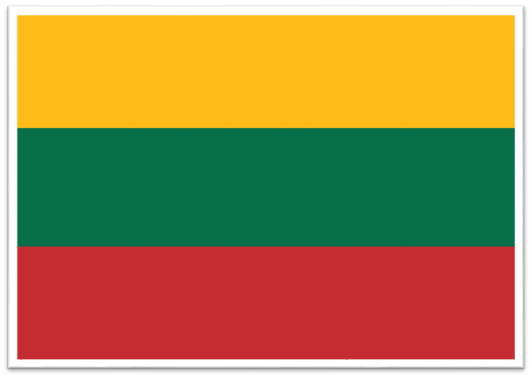The national flag of Lithuania, known as the "Vytis" or "Pahonia", is a symbol of the nation's rich history and enduring spirit of independence. Adopted on March 20, 1989, upon the restoration of Lithuania's independence from Soviet rule, the flag holds deep cultural and historical significance for the Lithuanian people.
The flag consists of three horizontal bands of equal width: yellow (top), green (middle), and red (bottom). The colours are symbolic, with yellow representing the golden fields of Lithuania, green symbolising the nation's forests and countryside, and red signifying courage, bravery, and the blood shed for independence.
At the centre of the flag's red band is a stylised representation of the historic Lithuanian coat of arms, known as the "Vytis" or "Pahonia". The emblem features a knight on horseback, holding a sword and shield, symbolising Lithuania's medieval heritage, chivalry, and defence of freedom.
Read Also : Logo Provinsi Banten
The origins of the Lithuanian flag can be traced back to the 14th century, when similar colours and symbols were used by medieval Lithuanian rulers. Over the centuries, the flag underwent various iterations and adaptations, reflecting changes in Lithuania's political landscape and historical circumstances.
During periods of foreign occupation and subjugation, including the rule of the Russian Empire and the Soviet Union, the flag was suppressed and banned as a symbol of resistance and defiance. However, it continued to be used unofficially by Lithuanian patriots and exiles, serving as a rallying point for the struggle for independence.
In 1918, following the end of World War I and the collapse of the Russian Empire, Lithuania declared independence and adopted a national flag similar to the current design. This flag was subsequently used until the Soviet occupation in 1940, when it was replaced by the red Soviet flag.
Read Also : Dari Bendera Armenia
Following decades of Soviet rule and oppression, Lithuania regained its independence in 1990, leading to the restoration of the national flag as a symbol of the country's sovereignty, freedom, and national identity. Since then, the flag has become a cherished emblem of Lithuanian patriotism, displayed proudly at official ceremonies, national holidays, and public events.
The national flag of Lithuania serves as a powerful reminder of the country's resilience, determination, and unwavering commitment to freedom and democracy. It is a symbol of pride and unity for the Lithuanian people, embodying the spirit of their nation's past, present, and future aspirations.
Labels:
LOGO
Thanks for reading National Flag Of Lithuania - History. Please share...!



0 Komentar untuk "National Flag Of Lithuania - History"